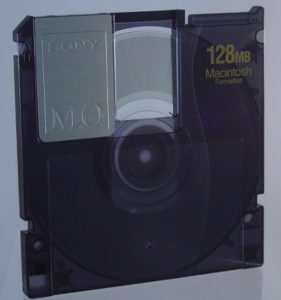History (1991): 3.5-Inch Magneto-Optical Disc
From 128MB to 1.3GB
This is a Press Release edited by StorageNewsletter.com on November 14, 2018 at 2:33 pmThis article was published by the Museum of Obsolete Media.
3.5-inch magneto-optical disc (1991-2000s)

Magneto-optical (MO) discs were a form of optical disc used for data storage, released commercially in 1985 in a 5.25-inch format, with a 3.5-inch version becoming available in 1991.
The disc consists of a ferromagnetic material sealed beneath a plastic coating. The only physical contact is during recording when a magnetic head is brought into contact with the side of the disc opposite to the laser. By default, MO drives verify information after writing it to the disc, and are able to immediately report any problems to the operating system. This means writing can actually take three times longer than reading, but it makes the media extremely reliable. MO discs are housed in a caddy for protection from dust.
The 5.25-inch discs were available in capacities from 256MB to 9.2GB, split over two sides. The drives used the SCSI interface, and mainly saw use in corporate storage and retrieval, such as legal document storage and medical imaging where high reliability, long life, and (at the time) high storage capacity were required. Optical libraries were available to automate loading and storing of the disks.
Their first major use was in the NeXT Computer in 1987, which initially offered a 256MB 5.25-inch MO drive.
The 3.5-inch discs were single-sided, with capacities ranging from 128MB to 1.3GB. They were available with different interfaces such as SCSI, IDE and USB and were more popular with consumers.
As with all removable storage media, the advent of cheap CD/DVD drives and flash memory has made them largely redundant. MO discs in particular were expensive when new, and while highly reliable, the slow writing time also was a drawback.
As of 2010, MO drives were no longer being manufactured.














 Subscribe to our free daily newsletter
Subscribe to our free daily newsletter

